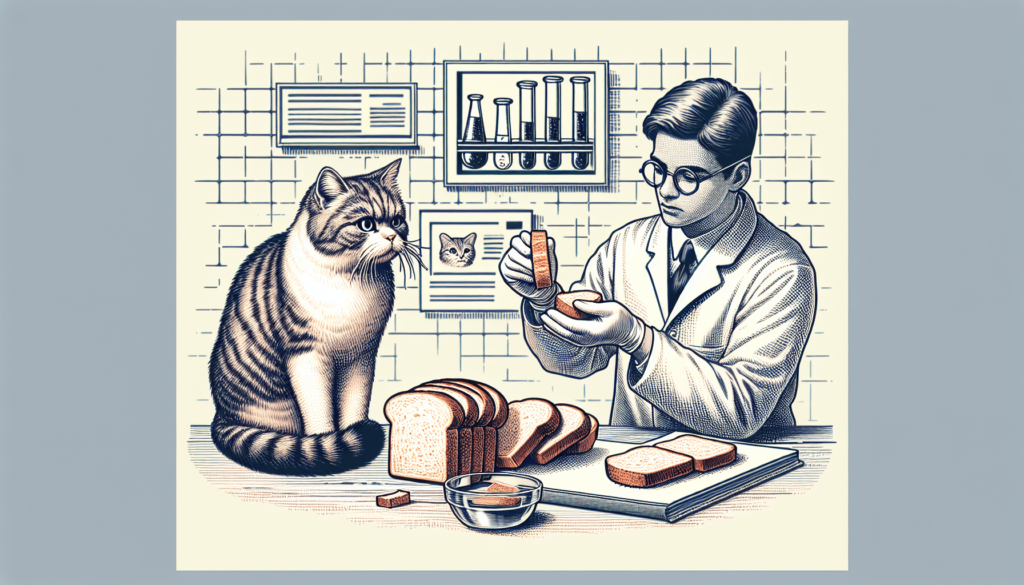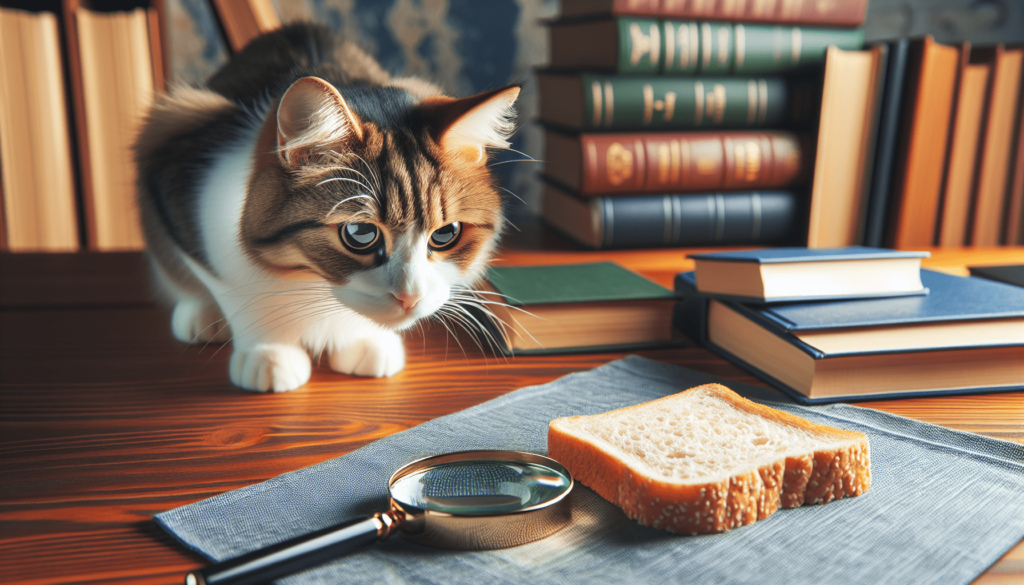Are you curious about the dietary habits of your feline friend? The question of whether cats can eat bread might have crossed your mind. In this article, we will explore the topic and shed light on whether it is safe or beneficial for cats to consume bread. So, let’s put this burning question to rest and discover the truth behind whether cats can indulge in this common human food.

Understanding Cats’ Dietary Needs
The carnivorous nature of cats
As obligate carnivores, cats have specific dietary needs that are different from other animals. Their digestive systems are designed to process animal-based proteins and fats efficiently. Because of this, a cat’s diet should primarily consist of high-quality sources of animal protein.
The importance of protein
Protein is a crucial component of a cat’s diet as it provides essential amino acids necessary for various bodily functions. Amino acids are the building blocks of proteins and are vital for muscle development, tissue repair, and the production of enzymes and hormones.
Limitations of a vegetarian or vegan diet for cats
Due to their need for protein from animal sources, a vegetarian or vegan diet is not suitable for cats. Cats require certain nutrients that are only found in animal tissue, such as taurine, which is essential for healthy vision and heart function. Without these essential nutrients, cats may develop serious health issues.
Can Cats Eat Bread? – A Short Answer
Bread is not toxic to cats
In small amounts, bread is generally not toxic to cats. It doesn’t contain any ingredients that are specifically toxic to them. However, it is important to note that bread should be given in moderation as it does not provide the necessary nutrients for a cat’s optimal health.
Why bread is not an ideal food for cats
While bread may not be toxic, it doesn’t offer any significant nutritional benefits to cats. Cats have specific dietary requirements, and bread simply doesn’t meet those needs. Feeding cats bread as a staple food can lead to nutritional deficiencies, weight gain, and potential health problems.
The Nutritional Value of Bread
Lack of essential nutrients in bread
Bread lacks many essential nutrients that cats require in their diet, such as taurine, arachidonic acid, and vitamin A. These nutrients are crucial for the overall health of cats and cannot be adequately replaced by bread alone.
High carbohydrate content in bread
Another nutritional concern with bread is its high carbohydrate content. Cats have a limited ability to digest and metabolize carbohydrates, as their bodies are designed to primarily use protein and fat for energy. Feeding cats a diet high in carbohydrates can lead to weight gain, digestive issues, and an increased risk of developing diabetes.
Potential Risks of Feeding Bread to Cats
The risk of obesity and diabetes
Feeding bread to cats regularly can contribute to obesity due to its high carbohydrate content. Obesity can lead to various health issues, including diabetes, joint problems, and a shortened lifespan. It is crucial to provide cats with a balanced diet tailored to their specific needs and to avoid foods like bread that can contribute to weight gain.
Possible allergic reactions
Some cats may have allergies or intolerances to ingredients commonly found in bread, such as wheat or gluten. Allergic reactions can manifest as skin irritations, gastrointestinal distress, or respiratory issues. It is important to monitor your cat for any adverse reactions when introducing bread into their diet.
Choking hazards associated with bread
Bread, especially when consumed in large pieces, can pose a choking hazard to cats. The texture and consistency of bread can cause it to get stuck in a cat’s throat or gastrointestinal tract, resulting in respiratory distress or digestive obstructions. It is essential to cut bread into small, manageable pieces if given as an occasional treat.

Bread Ingredients Harmful to Cats
Additives and preservatives
Some breads contain additives and preservatives that can be harmful to cats. These additives may include artificial sweeteners like xylitol, which is extremely toxic to cats and can cause severe complications such as low blood sugar and liver damage. It is vital to always read ingredient labels and avoid breads that contain harmful additives.
Toxic foods often found in bread, like onions and garlic
Certain types of bread, such as garlic bread or those containing onions, can be toxic to cats. Onions and garlic contain compounds that can damage a cat’s red blood cells and lead to anemia. Even small quantities can have detrimental effects, so it is crucial to keep bread varieties containing these ingredients away from cats.
Chocolate and raisins in sweet breads
Sweet bread varieties often contain ingredients like chocolate or raisins, both of which are toxic to cats. Chocolate contains theobromine, which can cause symptoms ranging from gastrointestinal upset to seizures and even death in cats. Raisins and grapes can lead to kidney failure. It is essential to keep all sweet breads containing these ingredients safely away from cats.
Is Any Type of Bread Safe for Cats?
Whole grain bread vs white bread
If you choose to give your cat bread as an occasional treat, it is best to opt for whole grain bread over white bread. Whole grain bread generally contains more fiber and nutrients, although it is still not a substantial source of essential feline nutrients. Remember to offer bread in moderation and always consider your cat’s specific dietary needs.
Gluten-free bread for cats with gluten allergies
If your cat has been diagnosed with a gluten allergy or sensitivity, you may consider offering gluten-free bread as an alternative. However, it is important to note that even gluten-free bread lacks significant nutritional value for cats. Consult with your veterinarian before introducing any new type of bread to your cat’s diet.
Unbaked bread dough and its risks
It is crucial to keep unbaked bread dough away from cats. When ingested, the dough can expand in their stomachs, leading to bloating and potentially dangerous situations. The yeast in the dough can also produce alcohol, which can be toxic to cats. Always store dough safely and keep it out of your cat’s reach.
Safe Alternatives to Bread for Cats
Safe fruits and vegetables
Instead of bread, you can offer your cat small portions of safe fruits and vegetables as treats. Cats can enjoy small amounts of cooked plain chicken, turkey, or fish as well. These alternatives can provide some variety in their diet while offering more nutritional value than bread.
Commercially prepared cat treats
For a more convenient option, there are commercially prepared cat treats available that are specifically formulated to meet a cat’s nutritional needs. These treats often contain ingredients that are beneficial for their overall health, such as high-quality proteins and specific vitamins and minerals. Always check the labels and choose treats that are appropriate for your cat’s age and health condition.
The Impact of Eating Bread on Cats’ Health Behaviour
How eating too much bread can affect feline behavior
Feeding cats excessive amounts of bread can contribute to behavioral changes. Cats may become more lethargic due to weight gain and a lack of essential nutrients. They may also show increased food-seeking behavior as their bodies crave the nutrients they are missing from a well-balanced diet.
Signs of bread-related health issues to watch
If you notice any changes in your cat’s behavior or health after introducing bread into their diet, it is important to watch for signs of potential bread-related health issues. These may include weight gain, gastrointestinal disturbances, changes in litter box habits, or skin irritations. If any concerns arise, consult with your veterinarian for guidance.
The Right Way to Introduce Bread to a Cat’s Diet
Introducing bread gradually
If you decide to introduce bread into your cat’s diet, it is essential to do so gradually. Start by offering small, bite-sized pieces as an occasional treat and monitor your cat’s reaction. If there are no adverse effects, you can continue to offer bread in moderation. Remember to adjust their overall diet to ensure they are receiving the necessary nutrients.
Monitoring your cat’s reaction
It is crucial to monitor your cat closely after introducing bread to their diet. Watch for any signs of digestive upset, allergic reactions, or changes in behavior. If there are any concerning symptoms or if your cat’s health deteriorates, discontinue feeding bread immediately and seek veterinary advice.
Consulting with a Vet Before Changing Your Cat’s Diet
Why the guidance of a vet is crucial
Before making any significant changes to your cat’s diet, it is always advisable to consult with a veterinarian. They can provide guidance based on your cat’s age, weight, health condition, and specific nutritional needs. They will be able to assess whether bread can be safely incorporated into your cat’s diet and recommend appropriate alternatives if needed.
How vets can determine the suitability of bread in a cat’s diet
Veterinarians have a deep understanding of feline nutrition and can evaluate the nutritional profile of bread and its potential impact on your cat’s health. They can also assess any underlying health conditions that may affect their dietary requirements. By working with a vet, you can ensure that any changes to your cat’s diet are made with their best interests in mind.
In conclusion, while bread is not toxic to cats, it is not an ideal food for them. Cats have specific dietary needs that are best met through a high-quality, meat-based diet. Bread lacks essential nutrients and can contribute to weight gain, digestive issues, and potential health problems. It is crucial to consult with a veterinarian before introducing bread or any significant changes to your cat’s diet to ensure their nutritional needs are met. Instead of bread, opt for safe alternatives such as small portions of fruits, vegetables, or commercially prepared cat treats specifically formulated for their nutritional requirements. Always prioritize your cat’s health and well-being when making dietary choices.

